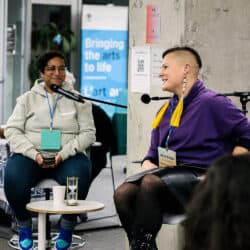Editor’s Introduction
This article is the second in a series of short articles that describe projects or programs in Waterloo Region. The previous article, D.B. Scott’s “Demand and Supply: The Region of Waterloo Arts Fund Lets the Arts Community Define What’s Important and Valuable.” was published in Vol. 20, No. 4.
Waterloo Region is a prosperous mixed-economy area in southwestern Ontario. It has three mid-sized cities with strong manufacturing and financial services industries. In addition, the surrounding rural areas are part of a significant agricultural base, which includes food-processing industries.
The purpose of the series is to show how one community is dealing with issues facing it and the organizations that serve the community.
It often seems as though fundamental societal change will only arise from a grand idea leading to transformation. Is this really the most effective method or can change be more subtle? Can transformation come about because someone has a simple and clear vision that is easy to grasp and implement? eyeGO to the Arts has proven that you can succeed with a simple and clear vision.
The eyeGO to the Arts program began in 2000 in Waterloo/Wellington Regions when community leaders concerned with the need to develop the next generation of arts goers and participants decided to be proactive. Through talking to students and discovering that they found ticket prices to be prohibitive, Centre In The Square general manager Jamie Grant came up with a concept to encourage high school students to come to his theatre. He made a commitment to provide five-dollar best-seat-available tickets to high school students for all the performances he presented. This means that, unlike rush tickets that allow students to buy cheap tickets only on the night of a performance, eyeGO tickets go on sale at the same time as single tickets, and students have the opportunity to purchase front-row seats, the same as adults do. Every performance is open to students, not just those that may not sell well.
Why make this kind of investment? For the performing arts community to flourish into the future, it is essential that there continues to be an audience. Live performing arts require an audience not only so that they are financially effective but also to succeed as art—fundamentally, the performing arts are interactive. Each performance reflects and affirms the relationship between the audience and the artist. We are, however, creatures of habit. As adults, we are more likely to be interested in the performing arts if we have experienced them as children. Today’s educational system is under increasing pressure and frequently sets aside the arts as a frill, forgetting that they are key to understanding many of the concepts we want our children to grasp. In 1997, the Canadian Association of Parks and Recreation produced a Benefits Catalogue that cited numerous studies relating to the role of the arts in the development and health of a community. It has been proven time and time again that exposing children to the arts augments the learning of many skills that are highly valued by our society. Recent Municipal Cultural Forums held throughout Ontario have underlined the need for a strong cultural sector as a vital component of a healthy community. Critical thinking, problem solving, and creativity are skills that employers want employees to exhibit. These skills can be learned through involvement in the arts, either directly as creators or indirectly as patrons.
Where are our future artists and patrons of the arts coming from? As with young hockey players who have professional idols, it is inspiring for youth to see professional artists perform. How many of our current artists decided to pursue their craft because they experienced a live performance? How many of our patrons can trace their love and commitment to the arts back to what they saw when they were young? If we agree that exposure to the arts is critical at a young age, then we have a choice. We can depend on others to bring students into our venues, or we can provide students with an opportunity to choose to come on their own. As expressed by eyeGO board of directors chair Bill Chesney, eyeGO is about the independent student making an independent choice to attend theatre.” Students agree that, for five dollars, they are willing to take a chance and go to see something they might not enjoy. eyeGO not only addresses the financial barrier, but it does so in such a way that arts organizations develop a relationship with the students attending.
eyeGO to the Arts = Five-dollar tickets to best-available seats
Students are exploring the arts and finding new areas of interest.
The ability of eyeGO to change the landscape of the performing arts in Waterloo/ Wellington Regions did not go unnoticed; communities across Canada began asking to be included. At this time there are communities in British Columbia, Saskatchewan, Manitoba, Ontario, New Brunswick, and Nova Scotia participating, and interest continues to grow.
Why is eyeGO to the Arts so successful? Fundamentally, it encourages arts organizations to treat high school students as valued patrons. It also empowers students to consider live performances as a viable entertainment option by giving them the same opportunity as adult patrons to purchase best-available tickets as soon as they go on sale, by allowing them to attend all performances, by not restricting their choice, and by making performing-arts tickets less expensive than movie tickets. In this way, all high school students have the opportunity to experience, by choice, the powerful and positive influence of live performance. By providing a healthy entertainment option for high school students, eyeGO to the Arts makes a positive impact on the youth of our communities.
In designing the structure of the program, deliberate decisions were made to keep it simple and accessible. Building on the power of collaboration, eyeGO encourages local arts programs to take responsibility for their own success in their community. eyeGO is, after all, a local program that gives students nation—al access to the performing arts. It is best if as many performing arts partners as possible participate so that students have the opportunity to explore many different performing arts disciplines, styles, and experience levels. eyeGo is also about developing relationships between the art organization and/or theatre and the student. Tickets are purchased at the box office of each organization, giving students the knowledge and confidence to go to the theatre. Greeting them as valued patrons begins to develop a long-term positive relationship. Students are not only able to enjoy the program, but they also have the opportunity to impact it by participating in youth councils. Students are the best ambassadors for the program, and those communities willing to work with them through a youth council can greatly increase the visibility and effectiveness of the program.
You mean it is just like going to the movies? I just go to the box office and tell them what I want to see?
Basically, it is that simple. For students, all it takes is five dollars, the name of the performance they wish to see, and a high school student card. They go to the box office to reserve their tickets and show the card again on performance night. In this way, they solidify the relationship with the performing arts organization.
Presenting partners commit to making 5% of their tickets available to high school students on a best-available-seat basis. Everything in their season is made available to students regardless of the potential for sales, and students can purchase eyeGO tickets as soon as single tickets go on sale. As a result, students feel that they are valued patrons of the organization.
This simplicity extends to the gathering of statistics. Statistics track the number of eyeGO tickets sold, the value of the investment made by each of the partners (the difference in value of an adult ticket minus the five dollars), and the arts discipline involved (primarily based on StatsCan). To do more would involve much greater resources at the local level and take away from the main purpose— to keep the program simple and accessible.
It is this very simplicity that has made the program not only successful but portable. With very little funding, eyeGO staff have expanded the program nationwide, taking advantage of every opportunity to tell the story.
Smaller communities benefit from the program through the eyeGo website and the knowledge that their students can also attend eyeGO events anywhere they are available. The program is not specific to a geographic region—a student who is aware of the program and how it works can access it in any participating community.
The safeguard for an organization is that its commitment is for no more than 5% of its tickets. Tickets sales are, however, on a first-come, first-served basis. If students do not take advantage of the eyeGo program when tickets go on sale and the general public’s demand for a particular event is particularly high, tickets may be sold out without a single eyeGo ticket being sold. Students quickly learn that it is best to purchase their tickets early. eyeGO provides marketing materials, support, and advice and access to a national website that allows students to see what is available across the country.
The keep-it-simple philosophy extends to the organization’s structure. eyeGO operates as a virtual organization. There is no physical office. Staff are hired on an as-needed basis for specific tasks. Much of the outreach has taken the organization’s basic philosophy of building strength through numbers even further. Through developing relationships with networking organizations such as Ontario’s presenting network, CCI or BC Tours, eyeGO has been able to accelerate its growth. Recent partnerships have included francophone presenting groups led by Reseau Ontario and TAPA’s hipTIX (Toronto). By working with these partners, eyeGO can operate with minimal resources to keep costs down and ultimately benefit the students. The support of the Ontario Trillium Foundation, the Winnipeg Foundation, Canadian Heritage, and the Ontario Arts Council has also assisted in spreading the word about the program to other communities.
Much of eyeGOs growth has been described as passive. An arts organization signs on, the website is updated to include its activities, and the organization begins telling existing patrons about the program. Students begin to discover it and tell their friends. Growth can be quite astounding with little effort.
It is possible to make a greater impact in a community. An outreach coordinator in the community recruits partners, develops and works with an eyeGO Youth Council, and talks about the program within the school system. Currently there are only a few communities that have an outreach coordinator. How exciting would it be as a student or an adult volunteer to introduce others to the excitement of a live performance!
The Youth Council is the final and key partner. The members become ambassadors for the program. They encourage friends to go to the theatre. They represent the program at their schools and often develop ideas for reaching their peers in ways that are specific to their particular school. They participate in fundraising for the program. Many student members may not start out as leaders, but through finding a way to provide information to other students and taking the first steps in choosing a new recreational activity, many develop leadership skills.
One young student who asked to be on the eyeGO Youth Council remarked that no one had ever solicited her opinion before. She became an engaged and active member. Another student who participated for the 40 hours of volunteer time he needed to graduate high school seldom spoke, but he attended every meeting, helped at every event, and put in far more hours than he needed.
eyeGO Youth Council members have designed and hosted media and outreach events ranging from workshops to conferences to public performances, and have participated in talk-back sessions at theatre outings that they arranged as a group. They are excellent public speakers and have appeared in various media, speaking about the impact that eyeGO has had on them. They are often brutally frank in their discussions and tireless in their energy. They have paid close attention to the fact that eyeGO allows them to get front row seats for shows that sell out. To them, rush tickets (those available within hours of a performance) are a sign that no one else wants to attend. If others don’t want to attend, why would they?
The Youth Council does not have to be restricted to the performing arts or to a single theatre. Working with other arts organizations helps strengthen the role of the Youth Council. Visiting a theatre one month for pizza, discussion, and a performance followed the next month by a trip to an art gallery for Chinese food, discussion, and a print-making class keeps the students engaged and strengthens ties between organizations. It is through making connections within the community that eyeGO has been able to expand nationwide with very little funding.
So, why only high school students? eyeGO is about the individual student making an independent choice to go to a performance. Performances that are traditionally sold to an adult audience are available to them; some of these may not be appropriate to younger students. Entering high school represents a new stage of life for young people and being able to decide what they see at the theatre should become part of this growth. Following high school, it is our hope that they will continue to attend and take advantage of student-priced tickets. Perhaps one day there will be a program for university students as well.
CHERYL A. EWING
Arts Consultant and Director of Development, eyeGO to the Arts


